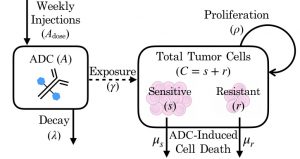 When a drug fails, often a mismatch between drug and target is blamed, and in brain tumors, there is also a possibility of insufficient amounts of drug being delivered to all of the brain tumor. In dense tumor regions, there is a break down of the blood-brain barrier due to tumor angiogenesis, which may allow drugs to enter the tumor. However, this does not occur in the outer regions of tumor where smaller numbers of tumor cells invade and spread outward, potentially leaving a large portion of tumor undertreated. To explore these dynamics, MNO lab postdoc Susan Massey and recent ASU graduate Javi Urcuyo developed an ordinary differential equation model based on experimental data from our Mayo Clinic colleague Jann Sarkaria’s Translational Neuro-Oncology lab. Our model shows how overall exposure to treatment may be more influential than therapeutic resistance in determining the therapeutic outcome.
When a drug fails, often a mismatch between drug and target is blamed, and in brain tumors, there is also a possibility of insufficient amounts of drug being delivered to all of the brain tumor. In dense tumor regions, there is a break down of the blood-brain barrier due to tumor angiogenesis, which may allow drugs to enter the tumor. However, this does not occur in the outer regions of tumor where smaller numbers of tumor cells invade and spread outward, potentially leaving a large portion of tumor undertreated. To explore these dynamics, MNO lab postdoc Susan Massey and recent ASU graduate Javi Urcuyo developed an ordinary differential equation model based on experimental data from our Mayo Clinic colleague Jann Sarkaria’s Translational Neuro-Oncology lab. Our model shows how overall exposure to treatment may be more influential than therapeutic resistance in determining the therapeutic outcome.
S. C. Massey, J. C. Urcuyo, B. M. Marin, J. N. Sarkaria, K. R. Swanson. Quantifying glioblastoma drug response dynamics incorporating resistance and blood brain barrier penetrance from experimental data. Bulletin of Mathematical Biology, in review. BioRxiv doi: 10.1101/822585
